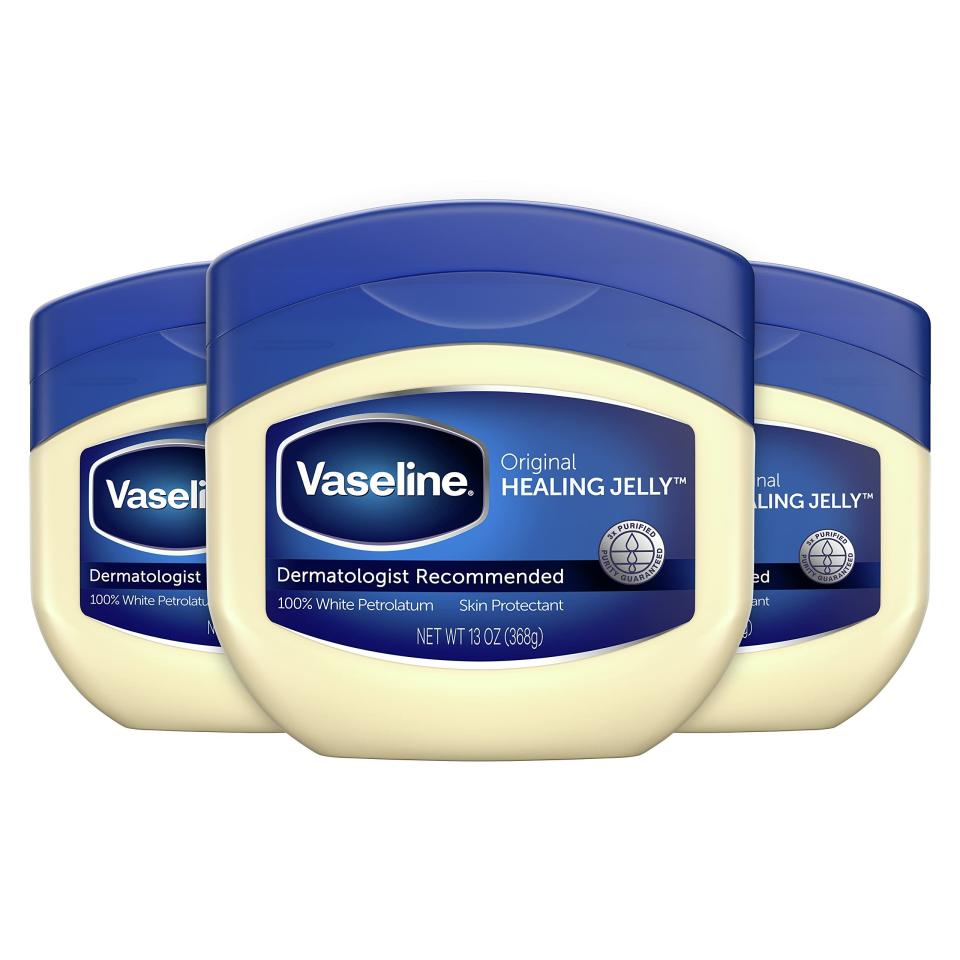So...What's The Big Difference Between Aquaphor And Vaseline?

"Hearst Magazines and Yahoo may earn commission or revenue on some items through these links."
Chapped lips, cracked elbows, dry skin, peeling tattoos...even a baby's diaper rash. If you've ever dealt with any of the aforementioned issues (and it's very likely you have), there's a good chances that at least one person has suggested Aquaphor or Vaseline as the ultimate healers. Both are highly versatile emollients that are readily available at your local drugstore, but are they the same thing?
Meet the experts: Belinda Tan is a physician-scientist and co-founder and CEO of People Science. Dr. Samuel Hetz, BSc, is the medical director of Concept Medical in Ottawa, Canada.
We asked dermatologists for help decoding the two formulas to find out which one comes up on top: Aquaphor or Vaseline.
The ingredients
Though Aquaphor and Vaseline are similar—and can be used in many of the same ways—they're inherently different products:
Vaseline ingredients
"Vaseline is an American household brand name for a petroleum jelly product that has been manufactured since the 19th century," says Belinda Tan, a physician-scientist and co-founder and CEO of People Science. Vaseline’s petroleum jelly is made entirely of white petrolatum, which is a mixture of hydrocarbons (organic compounds found in nature or fossil fuels), she explains.
"This is important for people to understand, since other beauty or skin products like jojoba oil may be viewed as 'cleaner,' but in reality, they are all naturally compounded products that have hydrocarbons along with other chemical ingredients."

Vaseline Petroleum Jelly Original 3 Count Provides Dry Skin Relief And Protects Minor Cuts Dermatologist Recommended And Locks In Moisture 13oz
amazon.com
$13.62
Aquaphor ingredients
The brand name "Vaseline” has been generically used by many people for any petroleum jelly product, no matter the brand, similar to how people use the term Band-Aid for all bandages or Kleenex for tissues. But Aquaphor, another household brand name for a German skincare ointment that has been around for almost 100 years, also contains petroleum jelly.
But it differs in one very important way: The formula has more than one ingredient. In addition to 41 percent petrolatum (the same active ingredient as Vaseline), Aquaphor also contains a few other inactive ingredients like other mineral oils and wax extracted from natural ingredients, humectants, bisabolol, and vitamins such as panthenol, adds Dr. Samuel Hetz, BSc, medical director of Concept Medical.

Aquaphor Healing Ointment, Advanced Therapy Skin Protectant, Dry Skin Body Moisturizer, Multi-Purpose Healing Ointment, For Dry, Cracked Skin & Minor Cuts & Burns, 14 Oz Jar
amazon.com
$15.97
The benefits
So if both products are emollients that help lock in moisture and relieve dryness on the skin and lips, among other uses, how do you decide which one to use?
Vaseline benefits
"Vaseline has been used and trusted by consumers for more than 150 years," says Tan. "It is a very simple product—100% white petrolatum with no other elements included." Because of this, Vaseline is used as part of many people’s home remedies and beauty regimens: to protect skin from the elements, to repair a wound, to help heal eczema, and to remove cosmetics, just to name a few. (Vaseline's own website cites 101 uses.) Most commonly, though, Vaseline is used on particularly dry skin, such as cracked lips and ankles, to help trap moisture in the skin and allow the skin to heal, says Dr. Hetz.
Aquaphor benefits
Aquaphor can be used for the same uses as Vaseline. However, "it tends to be a better choice for moisturizing wounds that need to breathe to some extent, as it does not block air to the same extent that Vaseline does," says Dr. Hetz. Also, some people enjoy the consistency of Aquaphor better—particularly for use on the lips—since it's a little lighter and more closely resembles Chapstick, he adds.
The side effects
Both Aquaphor and Vaseline are mainstream products that have been used for decades, but do either have any common—or rare—side effects you should know about? Since both products are topicals, you shouldn't ingest them, says Tan. "Swallowing Vaseline or Aquaphor could result in an upset stomach."
Vaseline side effects
Side effects from using Vaseline are highly unlikely, says Hetz. "In the cases they do appear, they are usually very minor: minor itching, irritation, burning and redness are possible, but rare." Additionally, if you take part in skincare trends such as "slugging," which requires applying layers of Vaseline on the face, you may risk breaking out, especially if you have oily and acne-prone skin.
Aquaphor side effects
Aquaphor does not commonly cause side effects, either, says Tan. "The main side effect, if any, is worsening breakouts."
So which should you choose: Aquaphor or Vaseline?
The bottom line: Don't stress. Both products work well to treat common skin issues like eczema, minor cuts and scrapes, and dry skin. And, in both cases, side effects are uncommon. In rare cases, redness, itchiness, or burning at the application site may indicate an allergic reaction to petroleum or lanolin or cuts may become infected it not cleaned properly prior to application.
"It really comes down to cost and preference for a particular feel or consistency," says Tan. And it's worth noting, she adds: If your dermatologist's office seems to stock samples of one—not the other—it doesn't necessarily indicate preference.
"For marketing purposes, skincare brands provide samples at no cost to dermatology clinics and these samples then get distributed to patients," she says. "So it is good to be aware that just because your dermatologist is providing a sample product, this doesn’t necessarily mean that they endorse that product over other brands." If you're ever unsure what's best for your own skin and personal needs, check in with your practitioner for tailored advice.
You Might Also Like